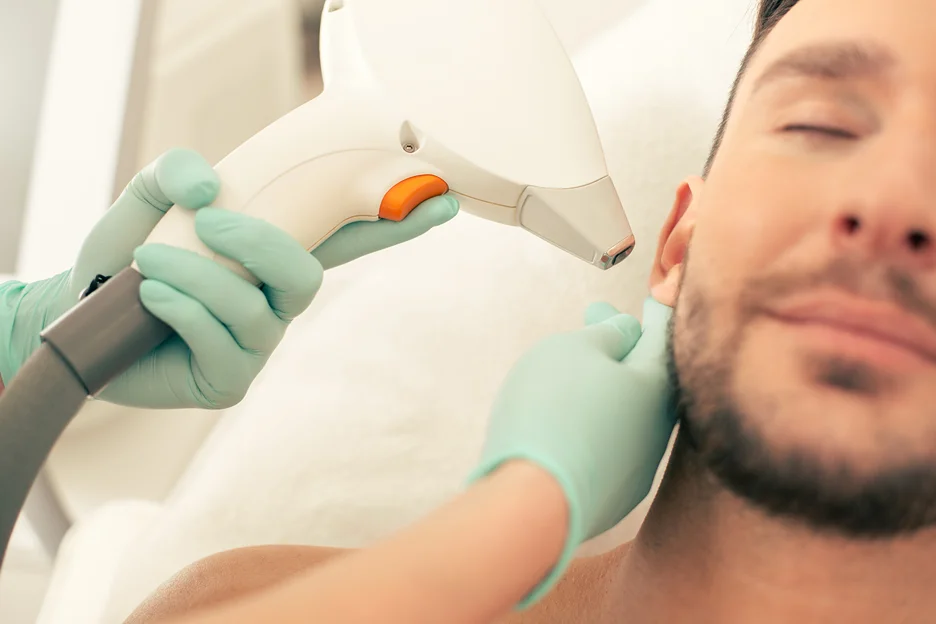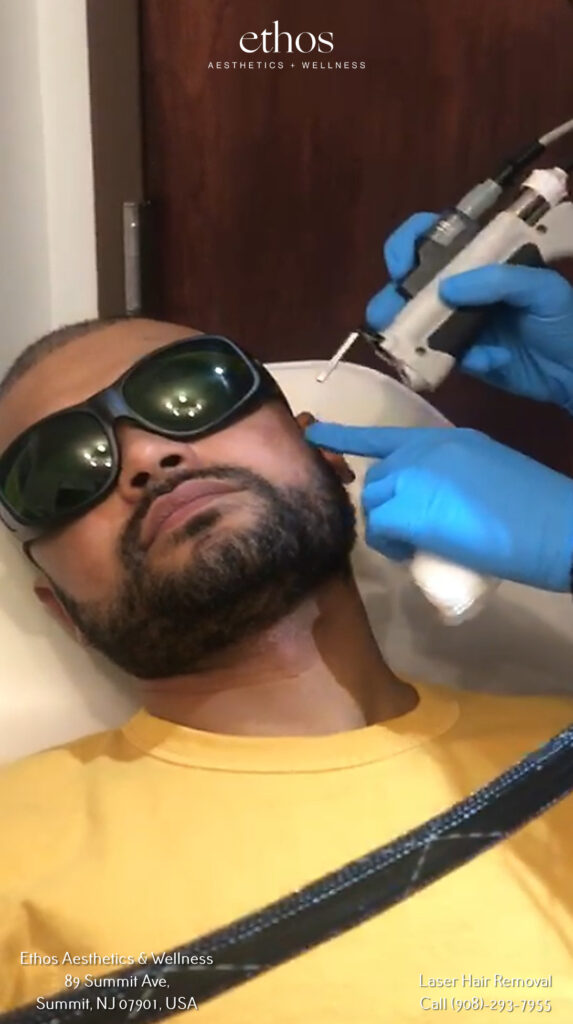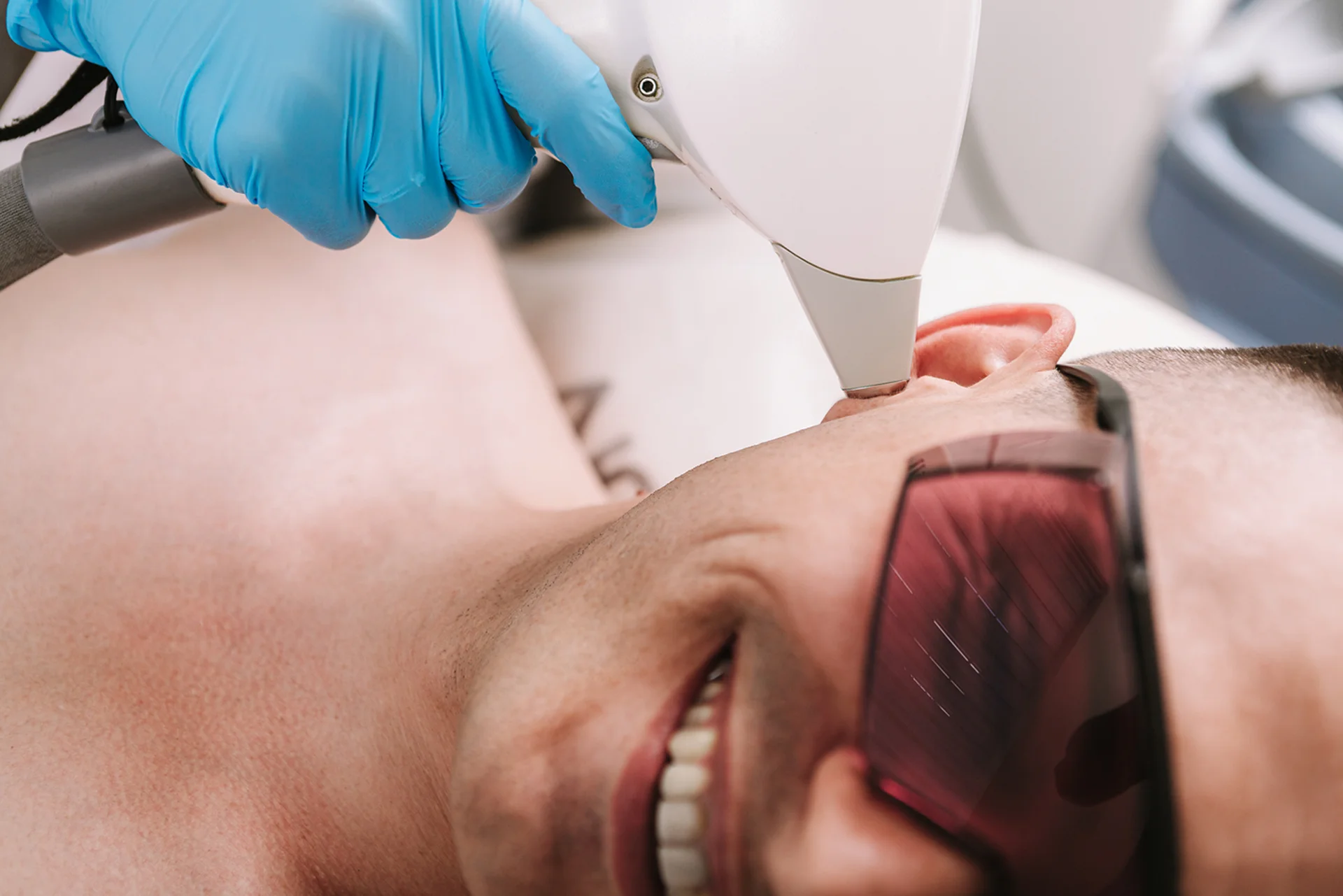Unwanted ear hair got you down? Those unsightly tufts sprouting from your ears can make you feel self-conscious and messy. While trimming and plucking provide temporary solutions, razor burn, ingrown hairs, and constant maintenance quickly become a hassle. Fortunately, laser hair removal offers a lasting way to say goodbye to annoying ear hair.
Imagine never having to trim your ear hair again. No more nasty razor cuts or painful plucking. Laser hair removal can make unwanted ear hair a thing of the past. This innovative technology uses highly concentrated light energy to target and destroy hair follicles on the ears and elsewhere on the face and body.
Treatments are fast, safe when performed properly, and lead to permanent hair reduction over time. If you’re tired of dealing with ear hair upkeep, laser hair removal treatment may be the perfect permanent solution.
Anatomy of Ear Hair: Vellus vs. Terminal Hair
Both vellus and terminal hair play distinct roles in the body’s hair profile. While their general characteristics might be well-known, it’s in their finer details where we truly see their function and distinctness, especially when we focus on ear hair.
Vellus Hair
- Definition: Vellus hair is your body’s way of giving you soft, fine hairs. They are light, short, and often go unnoticed. They’re the type of hair most people have as children before the onset of puberty.
- Location in the Ear: You can find vellus hair pretty much everywhere in the ear region – within the ear canal, on the pinna (outer ear), and gracing the earlobes.
Terminal Hair
- Definition: Post-puberty, the body gets into another gear and starts producing terminal hair. These are the coarser, visible hairs that are longer and usually darker than their vellus counterparts.
- Location in the Ear: Terminal hair tends to stay away from the ear canal. However, it isn’t shy to appear on the outer ear (pinna) and around the earlobes.
Excessive terminal hair, especially on the outer parts of the ear, is not uncommon. But if it bothers you, there are methods and treatments available for managing or reducing its appearance.
How Does Laser Hair Removal Work?
Laser hair removal takes advantage of the way hair follicles use melanin to grow. The highly pigmented granules in the follicles absorb light energy from the laser.
This creates heat that damages the follicle enough to inhibit future hair growth. Since melanin naturally occurs at higher levels in darker hair, lasers work best on black or brown hair.
Repeated treatments are needed because follicles cycle through growth phases and aren’t always active. But after a series of sessions, most patients enjoy up to 90% permanent hair reduction. The laser precision allows the surrounding skin to remain undamaged.
What To Expect During Ear Laser Hair Removal

The process for treating ear hair involves a few preparatory steps. The technician trims longer hairs and cleans the treatment areas. They apply a cooling gel for comfort. Eyewear protects your eyes from the bright laser light.
The technician then positions the handheld laser probe on each area of ear hair. As they activate it, you’ll feel a series of warm pinpricks or snaps. Each laser pulse targets a patch of hair follicles. Treatment takes just a few minutes per ear, far faster than electrolysis.
Afterward, the ears may be swollen, red, and sensitive for a day or so. Your doctor can prescribe a steroid cream to ease discomfort. Ingrown hairs, bumps, and minor burns are possible but rare when performed by an experienced professional.
The 7 Benefits of Laser Ear Hair Removal
Besides eliminating unwanted ear hair, laser treatments offer many advantages over temporary removal methods:
- Long-Lasting Outcomes: Laser hair removal is no fleeting solution. Its impact is observed in the prolonged reduction of hair growth, which stands in stark contrast to methods like waxing, shaving, or plucking. It may require a few sessions, but the results are worth the patience, offering months to years of smoother skin.
- Precision at Its Best: Ear hair can be tricky given its location. But the precision of lasers ensures that specific patches of hair are targeted without any collateral damage to the surrounding areas.
- Diminished Side Effects: Switching to laser hair removal means saying goodbye to the undesirable aftermath of other methods. There’s a significant drop in issues like ingrown hairs, abrasions, or immediate regrowth.
- Minimal Discomfort: For many, the thought of lasers may sound intimidating. However, the actual sensation during the procedure is often likened to a mild snap, much like a rubber band’s flick. And with modern techniques, any momentary discomfort is minimized.
- Economical in the Long Run: While the upfront costs might seem higher when you factor in the lasting results and the reduction in future expenses on other hair removal methods, it turns out to be a sound investment.
- No razor irritation or plucking pain: Lasers are far gentler than shaving, which can cause razor burns, bumps, and ingrown hairs on the delicate ear skin. Laser treatments are over in minutes without the sharp pains of plucking hairs one by one.
- Works on gray hairs: Lasers target all pigmented hairs, making them effective on coarser gray hairs that resisting plucking.
Guidelines for Post-Laser Ear Hair Removal Care
After getting your ears treated with laser hair removal, it’s super important to take care of the area. Doing this right helps everything heal smoothly and cuts down on any unwanted side effects. So, what should you keep in mind?
Prioritize Cleanliness
Gently cleanse the area using lukewarm water paired with a soft cleanser. Steer clear of soaps with potent fragrances or abrasive components. When drying, opt for a gentle pat-down with a soft cloth rather than a rub.
Sun Protection
The week following your treatment, minimize direct exposure to the sun. It’s crucial in preventing complications like sunburn or hyperpigmentation. For necessary outings, shield the treated area with a high SPF, broad-spectrum sunscreen.
Say No to Excessive Heat
For 24-48 hours post-treatment, hot showers, saunas, or any activity introducing excessive heat to the treated zone should be avoided. This reduces inflammation and ensures a swift recovery.
Keep the Area Hydrated
Regular application of a mild moisturizer helps combat dryness and redness. Choose products tailored for sensitive skin and devoid of fragrances.
Resist Touching
Avoid giving in to the temptation of scratching or picking at the treated area. Such actions can escalate irritation or even result in scarring.
Limit Hair Removal Methods
Post-treatment, while shaving remains permissible, refrain from waxing or plucking. Such practices can meddle with the healing trajectory.
Adhere to Professional Advice
Every individual is unique, and post-treatment guidance might vary accordingly. Always adhere to any additional recommendations or instructions provided by your healthcare professional.
Potential Side Effects and Risks of Laser Ear Hair Removal
While laser ear hair removal is a popular and often effective procedure, like any treatment, it comes with its set of potential side effects. Being informed can help you make an educated decision and take the necessary precautions.
Temporary Redness and Swelling: It’s quite common for the treated area to showcase some redness and swelling post-procedure. Typically, these symptoms fade within hours to a few days. Helpful remedies include a cold compress or applying aloe vera gel for relief.
Mild Skin Irritation: Some might experience skin irritations, manifesting as itching or a sensation akin to mild sunburn. This discomfort should dissipate within a few days. Refrain from scratching the area to avoid exacerbating the irritation or risking scars.
Changes in Pigmentation: Particularly in those with darker skin tones, there might be temporary pigment alterations, either darkening or lightening of the treated spot. Over time, these usually revert to normal.
Rare Occurrences of Blistering or Burns: Although not common, blisters or burns can result from the procedure, especially if the equipment is mishandled or the treatment is executed by a less-experienced technician. Selecting a well-reviewed clinic with experienced technicians is crucial.
Eye Safety: Laser procedures demand the utmost caution when it comes to eyes. Lasers can cause severe damage if exposed to the eyes. Proper protective eyewear is a non-negotiable during the session.
Alternatives to Laser Ear Hair Removal
When exploring hair removal solutions, especially for the ears, the landscape offers diverse alternatives beyond lasers. Below is a detailed breakdown to guide your choice.
| Method | Pros | Cons |
| Waxing/Tweezing | Provides longer-lasting results due to root-level removal. | Can be painful; may result in temporary redness or irritation. |
| Trimming | Fast, straightforward, and devoid of pain. | Results are temporary; hair grows back. |
| Depilatory Creams | Non-invasive method that dissolves hair at the skin’s surface. | Contains chemicals; necessitates careful usage and prior patch testing. |
| Electrolysis | Offers the allure of permanent hair removal. | Can be lengthy, demands multiple sessions, especially suited for smaller areas like ears. |
| At-Home Laser Devices | Provides the convenience of home-use while mimicking professional benefits. | Lower energy levels than professional treatments; essential to select FDA-approved devices and follow safety guidelines meticulously. |
Effective Ear Hair Removal Requires Skill
While lasers offer clear benefits for removing ear hair, treatments require expertise for safety and good results.
Avoid attempted laser hair removal at home or by untrained technicians. Improper treatment risks burns, scar tissue and even hearing damage if aimed near the ear canal.
Instead, choose an experienced provider like Ethos Spa. Their skilled laser specialists will:
- Carefully examine your ears and assess which areas need treatment.
- Select suitable laser settings based on your hair color and thickness. Darker, coarser hairs respond best.
- Customize treatment plans for permanent reduction within 6-8 sessions.
- Follow safety protocols to avoid inner ear contact.
- Provide proper aftercare to minimize discomfort and side effects.
With a professional’s help, laser ear hair removal can be a nearly painless, convenient solution for smooth, stubble-free ears that lasts.
Say Goodbye to Ear Hair Hassles

Unwanted ear hair can be embarrassing and tough to control. But thanks to laser precision, you can finally stop worrying about messy ear tufts.
With Ethos Spa’s experienced technicians and advanced devices, you’ll enjoy smooth, hair-free ears in no time. Our personalized approach targets ear hair trouble spots for good. You’ll look polished while eliminating a bothersome chore. Let the experts banish bothersome ear hair for good so you can feel confident and carefree.
Schedule a consultation today to get started with laser treatments!







